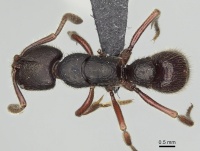Euponera tahary
| Euponera tahary | |
|---|---|

| |
| Scientific classification | |
| Kingdom: | Animalia |
| Phylum: | Arthropoda |
| Class: | Insecta |
| Order: | Hymenoptera |
| Family: | Formicidae |
| Subfamily: | Ponerinae |
| Tribe: | Ponerini |
| Genus: | Euponera |
| Species complex: | sikorae |
| Species: | E. tahary |
| Binomial name | |
| Euponera tahary (Rakotonirina & Fisher, 2013) | |
Endemic to Madagascar, E. tahary has been collected from the rainforests of the RS Ambatovaky in the east of the island. It forages mainly through the leaf litter and nests in rotten logs.
Identification
Rakotonirina and Fisher (2013) - Worker. Anteromedial margin of clypeus projecting anteriorly as a blunt angle; with head in full-face view, lateral margins before level of anterior margin of eye strongly curving towards base of mandibles; in lateral view, distance between eye and base of mandible roughly less than twice the maximum diameter of eye; antennal scape attaining posterior cephalic margin; posterolateral margins of propodeum and petiolar node with a series of sharp teeth or denticles; mesopleural suture indistinct, while broad and discontinuous lines in different directions may be present; second gastral tergite punctate to sparsely punctate, pubescence absent or reduced on first and second gastral tergites; head behind the level of eye mostly smooth and shiny on faintly effaced reticulate-punctate sculptures.
Keys including this Species
Distribution
Latitudinal Distribution Pattern
Latitudinal Range: -16.7633° to -18.8144°.
| North Temperate |
North Subtropical |
Tropical | South Subtropical |
South Temperate |
- Source: AntMaps
Distribution based on Regional Taxon Lists
Malagasy Region: Madagascar (type locality).
Distribution based on AntMaps
Distribution based on AntWeb specimens
Check data from AntWeb
Countries Occupied
| Number of countries occupied by this species based on AntWiki Regional Taxon Lists. In general, fewer countries occupied indicates a narrower range, while more countries indicates a more widespread species. |

|
Estimated Abundance
| Relative abundance based on number of AntMaps records per species (this species within the purple bar). Fewer records (to the left) indicates a less abundant/encountered species while more records (to the right) indicates more abundant/encountered species. |

|
Biology
Castes
Images from AntWeb
   
| |
| Worker. Specimen code casent0164205. Photographer Erin Prado, uploaded by California Academy of Sciences. | Owned by CAS, San Francisco, CA, USA. |
Nomenclature
The following information is derived from Barry Bolton's Online Catalogue of the Ants of the World.
- tahary. Pachycondyla tahary Rakotonirina & Fisher, 2013: 476, figs. 27, 61, 62, 63, 79 (w.) MADAGASCAR. Combination in Euponera: Schmidt & Shattuck, 2014: 87.
Unless otherwise noted the text for the remainder of this section is reported from the publication that includes the original description.
Description
Worker
(8 specimens): HW: 1.32–1.57, HL: 1.39–1.67, CI: 94–99, SL: 0.98–1.30, SI: 71–83, PW: 0.98–1.17, WL: 1.79–2.34, NH: 0.84–1.08, NL: 0.63–0.85, NW: 0.81–1.09, DNI: 122–132, LNI: 123–139.
Head subquadrate, roughly as long as broad, sides nearly parallel posteriorly before curving abruptly from level of eyes towards base of mandibles; posterior border with weak median excision. Head dorsum reticulate-punctate, with large, smooth, and shiny spaces between punctures; sculptures become punctate and sparsely punctate near posterior margin and sides, respectively. Eyes medium, protruding from head surface, with more than 25 ommatidia; distance between eye and base of mandible approximately less than twice the maximum diameter of eye. Antennal scape barely surpassing posterior margin of head. Median lobe of clypeus convex, anterior margin projecting anteriorly into a median convexity or blunt angle. Mandibles smooth and shiny, with scattered piliferous punctures; masticatory margins with ten teeth or denticles.
With mesosoma in dorsal view, metanotal groove absent; mesosoma dorsum mostly smooth between scattered punctures; blunt rugae or tubercles present on pronotum. In lateral view, mesopleural sulcus indistinct, and a broad superficial impression may be present; posterolateral border of propodeum with a series of teeth or tubercles. In profile, lower half of posterolateral margin of petiole node with a series of teeth or tubercles; dorsum and lateral surface of node coarsely bluntly tuberculate. In dorsal view, lateral margins of node forming a convex line to generally rounded anterior border; posterior margin slightly convex. Anterior face of first gastral segment without shallow cavity; first and second gastral tergites punctate laterally, the punctures becoming widely spaced dorsally. Erect hairs long and thin; pubescence abundant on head and pronotum, but gradually reduced or absent from rest of mesosoma dorsum to second gastral tergite. Color black with bluish or opalescent reflection; appendages and tip of gaster brown.
Type Material
Holotype worker: Madagascar, Toamasina, RS Ambatovaky, Sandrangato River, -16.7727, 49.2655, 450 m, rainforest, ex rotten log, 20 Feb 2010 (B.L. Fisher et al.), collection code: BLF24323, specimen code: CASENT0162668 (California Academy of Sciences).
References
- Rakotonirina, J.C. & Fisher, B.L. 2013. Revision of the Pachycondyla sikorae species-group (Hymenoptera: Formicidae) in Madagascar. Zootaxa 3683, 447-485.
- Schmidt, C.A. & Shattuck, S.O. 2014. The higher classification of the ant subfamily Ponerinae (Hymenoptera: Formicidae), with a review of ponerine ecology and behavior. Zootaxa 3817, 1–242 (doi:10.11646/zootaxa.3817.1.1).
References based on Global Ant Biodiversity Informatics
- Rakotonirina J. C., and B. L. Fisher. 2013. Revision of the Pachycondyla sikorae species-group (Hymenoptera: Formicidae) in Madagascar. Zootaxa 3683 (4): 447-485.

